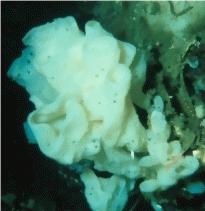
Hexasterophora are a subclass of glass sponges in the class Hexactinellida. Most living hexasterophorans can be divided into three orders: Lyssacinosida, Lychniscosida, and Sceptrulophora. Like other glass sponges, hexasterophorans have skeletons composed of overlapping six-rayed spicules. In addition, they can be characterized by the presence of hexasters, a type of microsclere with six rays unfurling into multi-branched structures.

Halichondria panicea, commonly known as the breadcrumb sponge, is a species of sea sponge belonging to the family Halichondriidae. This is an abundant sponge of coastal areas of the North Atlantic and the Mediterranean Sea ranging from the intertidal zone to a recorded depth of over 550 m. It is also found in the intertidal zone of the coast of the northern part of the North Island of New Zealand. It is very tolerant of a wide range of coastal habitats, including strong currents, high salinity and exposure to powerful wave action. Its only requirement is a rocky substrate which can include small cobbles.

Homosclerophorida is an order of marine sponges. It is the only order in the monotypic class Homoscleromorpha. The order is composed of two families: Plakinidae and Oscarellidae.

Lyssacinosida is an order of glass sponges (Hexactinellida) belonging to the subclass Hexasterophora. These sponges can be recognized by their parenchymal spicules usually being unconnected, unlike in other sponges in the subclass where the spicules form a more or less tightly connected skeleton. Lyssacine sponges have existed since the Upper Ordovician, and three families are still alive today. The Venus' flower basket is one of the most well-known and culturally significant of the glass sponges.
Pseudospongosorites is a genus of sea sponges belonging to the family Suberitidae. Currently, the genus is considered as monotypic, consisting of a single species Pseudospongosorites suberitoides. It is found in the Caribbean Sea, the Gulf of Mexico and on the Atlantic coast of the United States as far north as North Carolina. This species is known by the common name Florida hermit crab sponge, so named because hermit crabs often use it as shelter.

Euplectella is a genus of glass sponges which includes the well-known Venus' Flower Basket. Glass sponges have a skeleton made up of silica spicules that can form geometric patterns. These animals are most commonly found on muddy sea bottoms in the Western Pacific and Indian Oceans. They are sessile organisms and do not move once attached to a rock. They can be found at depths between 100 m and 1000 m but are most commonly found at depths greater than 500 m.

Euplectellidae is a family of glass sponges (Hexactinellids) belonging to the order Lyssacinosa, first represented in the Ordovician fossil record, substantially older than molecular estimates of the clade's age.

Rossellidae is a family of glass sponges belonging to the order Lyssacinosa. The family has a cosmopolitan distribution and is found at a large range of depths.
Sceptrulophora is an order of hexactinellid sponges. They are characterized by sceptrules, a type of microsclere with a single straight rod terminating at a bundle of spines or knobs. An anchor- or nail-shaped sceptrule is called a clavule. A fork-shaped sceptrule, ending at a few large tines, is called a scopule. A broom-shaped sceptrule, ending at many small bristles, is called a sarule.

Bolosoma is a genus of pedunculated siliceous sponges belonging to the family Euplectellidae. This genus lives in deep-sea environments and provides a habitat for a plethora of other benthic species, giving Bolosoma an incredibly important ecological role in the ecosystems it is a part of.
Michelle Kelly, also known as Michelle Kelly-Borges, is a New Zealand scientist who specialises in sponges, their chemistry, their evolution, taxonomy, systematics, and ecology.

Atlantisella is a genus of glass sponges (Hexactinellids) belonging to the family Euplectellidae, first described in 2002 by Konstantin Tabachnick.

Advhena is a monotypic genus of glass sponges in the family Euplectellidae. It contains the single species Advhena magnifica, also known as the E.T. sponge, after the titular character in the film E.T. the Extra-Terrestrial.
Euplectella cucumer is a species of glass sponge in the family Euplectellidae. It has been found around the Seychelles.
Euplectella paratetractina is a species of glass sponge in the family Euplectellidae. It has been found in waters off the coast of Australia.
Euplectella sanctipauli is a species of glass sponge in the family Euplectellidae. It is known from type specimens found off the coast of Brazil.
Caulophacus brandti is a species of glass sponges belonging to the subfamily Lanuginellinae. It is known from type specimens found in the Weddell Sea. The specific epithet was given in honor of Angelika Brandt.
Caulophacus discohexactinus is a species of glass sponges belonging to the subfamily Lanuginellinae. It is known from a type specimen found in the Weddell Sea. The specific epithet was given to refer to the discohexactine shape of the species' microscleres.
Caulophacus weddelli is a species of glass sponges belonging to the subfamily Lanuginellinae. It is the only species in the subgenus Oxydiscus. It is known from a type specimen found in the Weddell Sea, which lends its name to the specific epithet weddelli.








